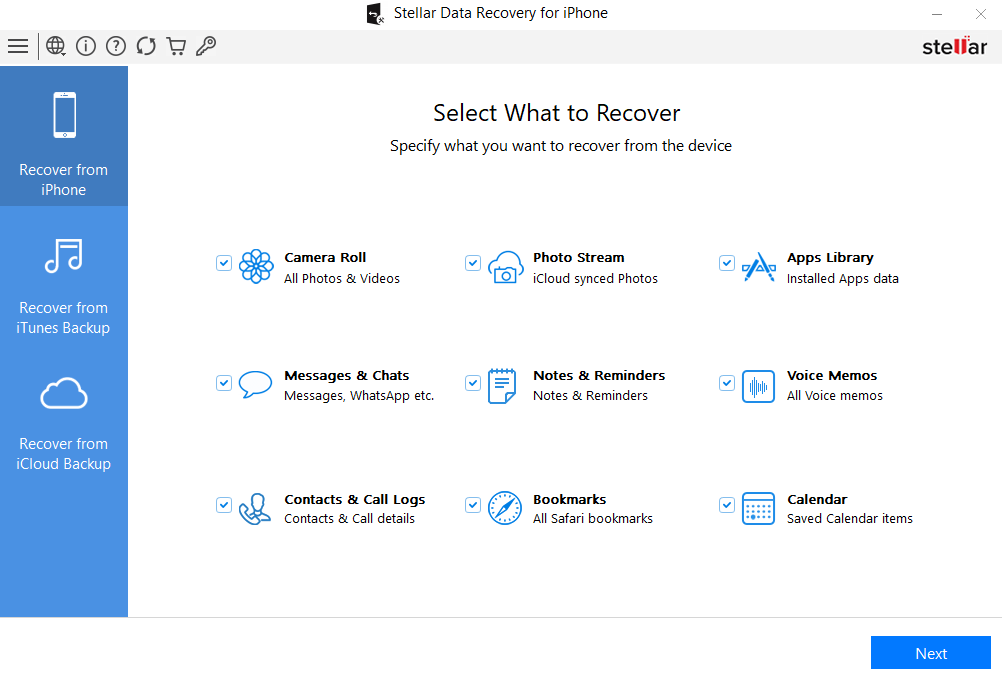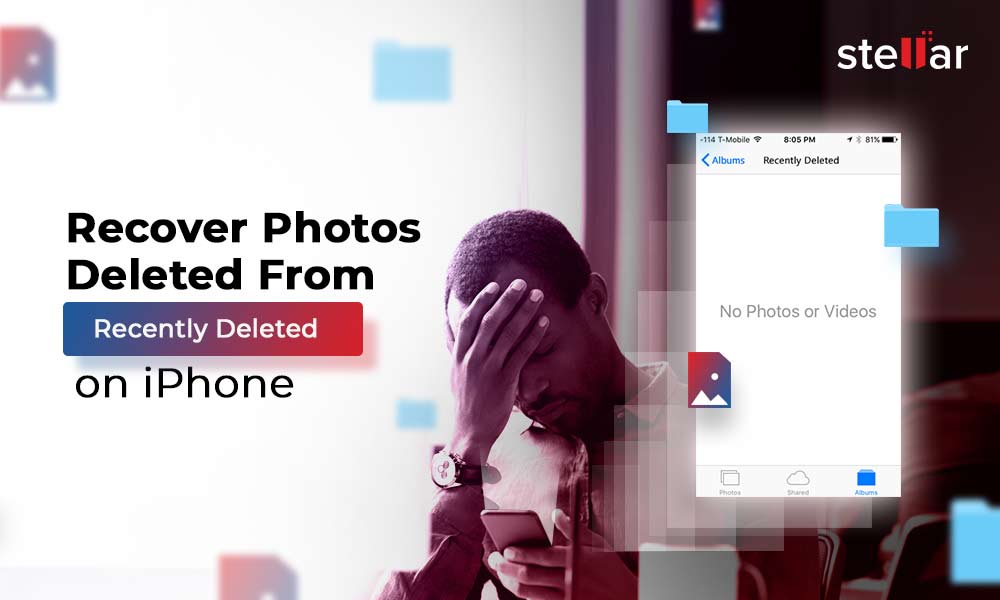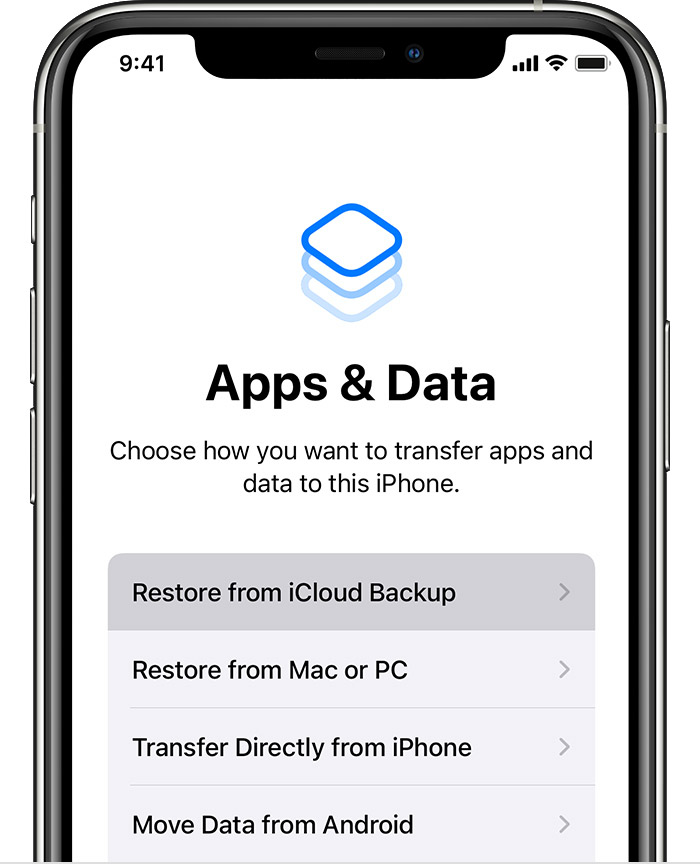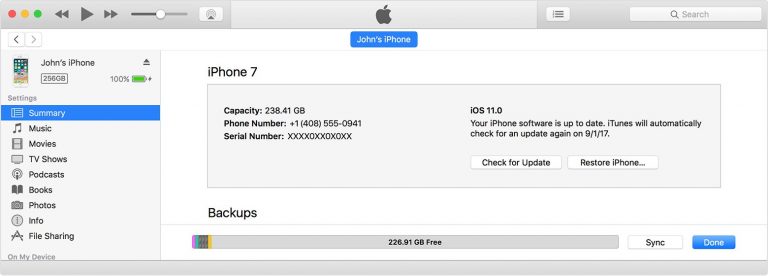
Recover Deleted iPhone 12 Pro Max WhatsApp Attachments on Mac and Windows | Stellar

Recover Deleted iPhone WhatsApp Attachments on Mac and Windows
Your iPhone has simplified your life to a great extent by making your daily task feasible. You can check your emails, send and receive text messages, WhatsApp messages, and attachments, browse the Internet, capture precious moments, etc. But, there could be situations, where the critical data stored on your iPhone might accidentally get deleted, especially the messages and attachments stored on your WhatsApp.
This situation often occurs when cleaning up the unwanted messages from the message boxes. Nevertheless, landing up in such a situation is disastrous.
With Stellar Data Recovery for iPhone, you can now recover lost or deleted iPhone WhatsApp attachments both on your Mac and Windows based systems. It is a highly reliable data recovery software that is capable of recovering your lost or deleted data from your iPhone, iTunes, and iCloud.
Steps to recover iPhone WhatsApp Attachments
Follow the below-mentioned steps, to recover deleted iPhone WhatsApp attachments on your Mac and Windows-based systems with Stellar Data Recovery for iPhone.
Step 1) Install Stellar Data Recovery for iPhone on your Mac or Windows based system
Step 2) Connect your iPhone to your system
Note: You can connect multiple devices and the software will list up the connected devices
Step 3) Double click on the icon of the software and the main screen will open as shown below

Step 4) To recover from your iPhone, click on the Recover from iPhone option displayed on the main screen and select “Message & Chats” option from the list.
Step 5) The software will scan the selected device and list all the items on your phone
Step 6) You can select WhatsApp option from the list
Step 7) Now click on the save button to save the files
Step 8) Provide the location where you would want the recovered data to be saved.
Note: You can import the recovered data to your iPhone but this option is available only when you recover the data in a Windows based system.
To sum up, whenever you are in a situation where you have lost or accidentally deleted WhatsApp attachment from your iPhone, you can rely on Stellar Data Recovery for iPhone. This is a highly-efficient software that is capable of recovering all your lost or deleted data from iPhone, iCloud, and iTunes backup. With this software, you can save all your recovered messages and attachments at your preferred location on your computer.
How to recover deleted photos after deleting from ‘Recently Deleted’ on iPhone
The Recently Deleted folder in the Photos App on iPhone is there to recover accidentally deleted photos. However, even if your important photos are deleted from ‘Recently Deleted’ you are not yet out of luck. This post shares how to recover deleted photos after deleting them from ‘Recently Deleted’ on iPhone.

‘I deleted some important pictures on my iPhone and also deleted them from the ‘Recently Deleted’ folder. Is there any possible way to recover photos after permanently deleting them from the iPhone?’
When you delete photos from your iPhone, they first go to the ‘Recently Deleted’ folder of the Photos App. Here the photos remain for 30 days. Hence, any picture deleted 30 days ago automatically gets removed after this period, and this time permanently.
However, sometimes you may accidentally delete valuable pictures too. To make the situation worse, even remove image files from ‘Recently Deleted’ or realize the mistake 30 days after deleting!
In any case, can you get photos back after deleting from ‘Recently Deleted’ on your iPhone?
This post addresses the problem situation of permanently deleted photos from iPhones and finds the appropriate solution.
Let’s read on…
Understanding permanently deleted photo recovery from iPhone
You can recover deleted photos from your iPhone after deleting them from the Recently Deleted folder or 30 days of automatic deletion.
Of course, backups — iCloud and iTunes are the immediate go-through solution in such a case. However, Apple backups have their own disadvantage. Photo recovery with iCloud and iTunes results in the loss of your current data on your iPhone!
That’s the reason, iCloud and iTunes are frustrating when you want to get back only a few photos.
So, if you are using another backup service such as Google Drive or OneDrive for iPhone photo backup, they are more convenient.
In addition, apart from backup, iPhone recovery software is just the right solution. It works even when you don’t have a backup or don’t want to eliminate your existing data on your iPhone or iPad.
1. Recover ‘Recently Deleted’ photos from iCloud backup
Use an iCloud backup to recover deleted photos from your iPhone after 30 days of deleting them from the ‘Recently Deleted’ folder. iCloud backup is the best solution to retrieve permanently deleted photos from iPhone free.
Just get on to the below steps to recover deleted photos from iCloud:
- On your iPhone, navigate to Settings > General > Reset> Erase all Contents and Settings.

- Select Erase Now in the dialog box and follow the prompts until you reach the Apps & Data screen.
- Click on Restore from iCloud Backup.

- Sign in to your iCloud account.
- Select the recent backup from the list that has the deleted pictures. Click Restore to get back the deleted photos on your iPhone.
2. Recover permanently deleted photos from iTunes
If you have an iTunes backup, look for the deleted photos after deleting from ‘Recently Deleted’ in your iTunes backup.
Below are the quick steps:
- Connect your iPhone to your PC or Mac and launch iTunes.
- Click on your iPhone under the device list and select the recent backup date that may contain the permanently deleted pictures.

- Click Restore Backup.
That’s it. You get back the deleted photos on your iPhone. However, this will replace the current data on the iPhone with the old backup data.
3. Recover recently deleted photos from cloud storage
iPhone users, who don’t completely rely on iCloud and iTunes for backup, use third-party cloud backup solutions. If you are one of those, check your cloud storage for permanently deleted photos on your iPhone. Cloud backups such as Google Drive, iCloud, Dropbox, OneDrive, etc., are efficient ways to save and protect your photos on your iPhone from permanent loss. You can restore photos on a PC , Mac, or iPhone by using cloud storage.
4. Recover Recently Deleted Photos with iPhone recovery software [Recommended]
Some of you may not have photos backed up in iCloud or iTunes. It’s also possible you couldn’t find the desired picture in the backup. In any case, use the best iPhone recovery software to get pictures back after deleting from Recently Deleted on iPhone.
Try one of the popularly used Stellar Data Recovery for iPhone . It is compatible with not just old iPhones like iPhone 6, 7, 8, X, etc., but also the latest series of iPhone 15. You also get the latest iOS 17 support.
Stellar Data Recovery for iPhone can help to recover photos from the iPhone without backup. Additionally, you can retrieve lost or deleted contacts, messages, chat messages, Notes, Reminders, etc.
Besides, when you recover photos by using iTunes or iCloud, it gets back all data from the backup file whereas with the software you can select and recover only what you require. Unlike photo recovery from backup, the software doesn’t replace the existing data with old backup data on your iPhone.
Here are the steps to recover deleted photos after deleting them from the Recently Deleted folder on your iPhone:
- Connect your iPhone to your PC or Mac computer.
- Download and launch Stellar Data Recovery for iPhone on a computer.
- On the first screen, select Recover from iPhone on the left pane. If required, you can choose the ‘Recover from iCloud’ or ‘Recover from iTunes’ option.

- Check-in Camera Roll and Photo Stream and click Next.

- The software scans and displays the recovered pictures. See preview, select, and save the desired photos.
Conclusion
An iPhone recovery software is the perfect approach to recover deleted photos from an iPhone after 30 days of deleting them from the ‘Recently Deleted’ folder. We recommend Stellar Data Recovery for iPhone. It is fast and can retrieve permanently deleted photos without affecting the current data of your iPhone. Unlike iCloud and iTunes backup, which annoyingly replace existing data with the old backup data, the software can restore only those photos, which you have deleted.
Take the free trial and ensure that Stellar Data Recovery for iPhone can retrieve permanently deleted photos from your iPhone.
What to do if iPhone is not listed when I run the software?
Your iPhone will only appear in the software if it is visible in iTunes on your computer. If your iOS device is not listed in the software, it means iTunes is not installed on your PC or Mac.
Download the latest version of iTunes and then launch the Stellar Data Recovery for iPhone software.
To launch iTunes on your computer:
When iTunes is not installed on your computer, Stellar Data Recovery for iPhone automatically generates the below message. It asks to download and install iTunes. You can click on ‘Click here’ to download iTunes.
If iTunes is already install on your computer and you don’t see your iPhone in the software, update your iTunes to the latest version.
New iPhone 14 Restore from iCloud Stuck on Time Remaining Estimating
Summary: The joy of using iPhone 14 comes to a halt if your newly purchased iOS device remains stuck at “iCloud backup remaining estimating time” loop. You’ll Google how to restart an iPhone but end up being confused about what to do or what not to do. We understand your angst. So, in this blog, we offer you lucrative options to restore new iPhone 14 from iCloud backup. Also, we have taken the liberty to recommend a reliable iPhone data recovery software to use in case of accidental data loss. Use the given buttons to free download and try it yourself.
Every time you buy a new iPhone, restoring backup becomes a vital necessity to finish the setup. Long wait to restore a new iPhone 14 is killing the joy of using the most awaited Apple product. You can restore iTunes or Finder backup using laptop or MacBook, but as soon as you perform iCloud backup on iPhone 14, the device gets stuck at estimated time remaining. It’s a prominent issue, pointed by many iPhone 14 users recently.
The problem arises at setting up a new iPhone with existing iCloud backup. Possibility of getting stuck on Restore in Progress: An estimated storage (XXGB) required to finish restoring your apps and data.
Why is my new iPhone 14 stuck at restore from iCloud?
Before finding your options to overcome the problem and learn how to restore an iPhone, get familiar with the root cause of the problem:
- Perhaps additional data storage space is required.
- Apple server is preventing iCloud data restoration.
- iCloud system status is not working for iCloud backup and iCloud Account login.

- Slow or unstable WiFi connection.
- Numerous unwanted backup files stored on iCloud.
Generally, restoring in progress doesn’t take more than 20 to 60 minutes for an iPhone to restart. Nonetheless, if restoring is stuck beyond that time, then be wary that it might take hours to finish. Anyhow, iPhone offers you ample options to get around a stuck iCloud backup.
How to restart an iPhone stuck at “Restore from iCloud- Time Remaining: Estimating”
Read the below methods to identify a perfect route to finish restoring iPhone 14 from iCloud backup. You can also stop restoring your iPhone and experiment with other alternatives:
Cancel the iCloud Restore in Progress
Stop the ‘Restore from iCloud’ process and start afresh after giving rest to your iPhone for a while. The move allows iOS device to optimize operations after turning off all the activities. To do so, you need to interrupt the ongoing restore from iCloud backup, which is already stuck at a specified time remaining. Rebooting your iPhone will fix all the minor glitches liable for creating such. Follow these steps:
- Press and hold the side button (on the right hand side of your iPhone) along with volume up/ down button till the power-off slider appears on your iPhone 14 screen.

- Drag the slider to your right and wait for 30-seconds to turn off the device.

- To turn the iPhone back on, press and hold the side button until the Apple logo appears on screen.

Restart Restoring iCloud Backup
Once your iPhone 14 restarts, follow these steps to restore iCloud backup:
- Go to Settings > General > Transfer or Reset iPhone > Reset > Reset All Settings.

- Set up your iPhone and select Restore from iCloud Backup on the Apps & Data screen.
- You can also choose another restoration option- Transfer Directly from iPhone.
- Follow the instruction available on-screen to restore your iOS device.
If your new iPhone 14 continues getting stuck at iCloud restore progress, then you need to check your internet connection. Also, make sure the iOS device has adequate space to handle large volume of data you are trying to copy in it.
Check the iCloud System Status
At rare occasions, even Apple server prevents the iCloud data restoration. The first thing you can do in such situations is to ascertain whether the restore process was stalled because of an internet issue or iCloud System Status. To do so, go to Apple system status page and check if iCloud Backup, Apple ID, and iCloud Account and Sign In, are working. If not, then you can’t do much but wait for Apple support to fix the issue at their end.
iCloud backup restore stuck while setting up a new iPhone 14 is not stressful until you lose a significant amount of data in the process. It is possible that in the search and trial of different options to restore iCloud backup on new iPhone 14, you might lose a significant amount of data. Use a reliable iPhone data recovery software like Stellar Data Recovery for iPhone to restore all the lost or deleted iPhone data from different variants of iPhone, iPad, and iPod touch.

Note that the software also supports recovery from iCloud backup and iTunes backup. The advanced software allows you to select and restore only a selected few or the desired files lost from iCloud. Moreover, the iOS recovery software executes recovery in the least possible time and could manage every bit of data stored in your iCloud backup. Refer to our KB to learn how to recover deleted iCloud data .
Conclusion:
This blog encapsulates various methods to swiftly get out of the trouble of new iPhone 14 stuck at restore from iCloud. As you try these methods, eventually, you will find the most suitable option to resolve the iPhone 14 stuck at restore from iCloud error. At times, the process of data restore remains slow for reasons beyond your control. Perhaps the files you wish to restore to the newly purchased iOS device are way too large or the process is taking longer because of a weak Wi-Fi network or the Apple Server is undergoing maintenance. Either of the reasons may further enhance the risk of data loss on the iPhone. Therefore, you need an infallible solution like Stellar Data Recovery for iPhone to retrieve lost contacts, photos, videos, apps, games, chats, and more.
- Title: Recover Deleted iPhone 12 Pro Max WhatsApp Attachments on Mac and Windows | Stellar
- Author: Vivienne
- Created at : 2024-07-17 04:38:07
- Updated at : 2024-07-18 04:38:07
- Link: https://review-topics.techidaily.com/recover-deleted-iphone-12-pro-max-whatsapp-attachments-on-mac-and-windows-stellar-by-stellar-data-recovery-ios-iphone-data-recovery/
- License: This work is licensed under CC BY-NC-SA 4.0.






